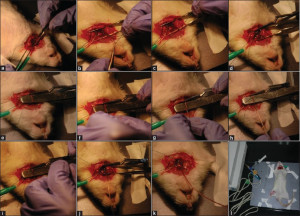Week 4 July 6- July 10, 2015
This week we did 24 catheter IV surgeries with our mentor Molly. She works as a technician for the George Lab. It was really cool to see how they are actually placed in the rat and what rat surgeries are like.
The rats are first anesthetized and put under with isoflurane in the holding chamber, a square, clear plastic box, so they don’t feel any pain. Once they have fallen asleep we remove the rat and shave the area around the right jugular vein and about a two by three inch section of the back. Both spots are cleaned and disinfected with alcohol pads and iodine pads. After we weigh them, Molly takes the rat and starts the surgery.
She first cuts into the neck and locates the jugular vein, removing all muscle and tissues that are attached to it so that it is isolated. She then flips the rat over and moves it onto its back so that the jugular vein can re-pump with blood. She makes an incision in the back then separates the skin from the muscle, making a small cavity all the way to the incision at the neck and a one on the back. In this area the catheter is threaded through and pushed up through a hole in the middle of the back’s skin. The tubing is threaded through the cavity and inserted into the jugular vein. This is the most difficult part because, although the vein is super resilient, it is still small and can be finicky. Sometimes rats also have blood clots in this vein that, when threaded with the tube, break and cause the rat to bleed out. This usually ends in death.
After the tubing reaches near the heart, and one can get a slight draw of blood in the needle connected to the catheter, the vein and tubing is hooked back to the surrounding muscle and then the incision is sewn up. Into the back cavity a substance of cefazolin and sterile water is squirted to prevent any air pockets that create abscesses and, though easy to deal with, are annoying. The back incision is closed, stitched up and both cuts have surgery glue applied to help them seal.
The rat is finally injected with flunixin, an analgesic that decreases the pain, similar to ibuprofen. The rat is then placed in a chamber, resting halfway on a heating pad and removed once he is awake and active. It is very entertaining to see them wake up because they still have some drugs in their system, flopping around as they try to stand up and walk.
Out of the 24 rats we did surgery on, 22 survived. Molly said that there is at least a 90 percent chance of the rat making it through surgery and usually only one in ten rats will die. Although they are such small creatures, the procedures and techniques used today are well developed to keep the rats alive and healthy for the upcoming experiment process.
Besides the surgeries we did the everyday task of cleaning cages. We also cleaned up the lab because it was scoped out on Thursday for a documentary being done on addiction. Olivier is a major part of this field, with the George Lab being a leading center started by the previous PI George Koob.



There are no comments published yet.